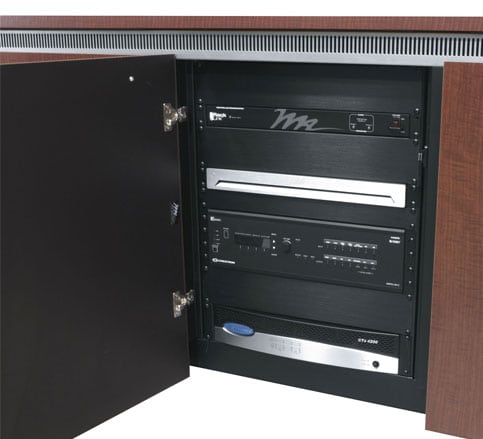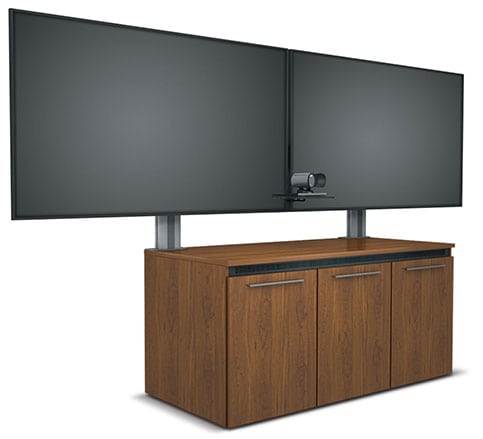Live edge tables are growing increasingly popular in the restaurant industry and in office environments, because of the natural, rustic appeal it brings to the space. Instead of angling off the edges, the wood’s organic features are left intact, making the piece truly unique. (In fact, AVI Systems has one.)
Imagine taking a saw to one of those. A drill, maybe?
Megan Knedler, director of product management – furniture at Legrand, North America, said that she’s heard of instances in which this has actually happened.
“We’ve heard a lot of horror stories of a really beautiful $10,000, $50,000 piece of furniture has had a hole saw drilled into it,” Knedler said.
The cause for this?
The audiovisual (AV) system wasn’t going to fit. The table wasn’t able to accommodate it, she said.
So, when it came time to install the system, an AV professional came in with a hole saw and hoped for the best.
“That’s not their expertise, they’re not crafters or woodworkers,” she said. “Don’t put them in this position.”
Unfortunately, beautiful pieces of furniture suffer this fate all too often because the right considerations weren’t taken into account beforehand.
“There are people who don’t think furniture is a part of AV,” she continued. “If you’re going to put it in a table, it houses the system.” The table will function the same way as a rack will.
Knedler said there’s also a common misconception that all data is in the cloud. When it comes time to outfit a space for an AV system – whether for a huddle room or flex space – the infrastructure can’t accommodate it. “There’s a disconnect there,” she said.
One way to bridge the gap is for the AV integration community to educate its counterparts in architecture and elsewhere, Knedler said. From the very start of a project, it’s critical to get every party, including clients, architects and AV folks, on the same page to avoid impromptu woodworking in the future.
Taking into account all of these details can be difficult for any one person. That’s why it’s best for the designer, the integrator and architect to run through as many options as possible with clients. This way, all considerations for installing AV equipment into the furniture and space are on the table (excuse the pun).
Check out this huddle room technology guide to design a space that meets your needs.
Related Video
ADDRESSING AV TECH NEEDS
Joyce Nemenyi, sales engineer and social media specialist at Marshall, said, “The first step is to determine what technology you'd like to house in the furniture. Preparing this information early in the process serves a dual purpose.”
The first part of that is getting this information organized to identify how much room you’ll need and how big the furniture will have to be, “since the cabinet must be sized around the equipment,” Nemenyi said.
The reason for that deals with heat. If technology overheats, it won’t function. Then, the whole room goes out of commission.
Knedler said, “In its most basic form, heat causes damage. You need to take into account the cable and thermal requirements. You’ve got to make sure you’re following all of the rules about heat and air … The heat needs to be able to escape.”
Communicating directly and providing this information about thermal requirements, cabling and more will help ensure the layout and design of the space meet the client’s expectations, while also functioning in a way that maximizes ROI.
When it comes to heat, some credenzas have strategically placed vents that allow heat to escape from the structure. In this way, heat can passively rise out of the credenza, which lessens the impact on AV equipment.
 Photo: Middle Atlantic
Photo: Middle Atlantic
However, some racks and housing units demand an active way of controlling heat. This could be a blower or a fan that is programmed to activate when needed.
Tip: “Dirty air is better than no air.” Knedler said that she’s seen more and more air filters going into racks and housing units to protect the equipment. These can cause more harm than good under some circumstances. If the filter isn’t replaced regularly, it can stop the flow of air in and out of the unit, which ultimately traps heat and damages equipment.
THE FIT, HIDDEN WIRES, AND SECURITY
You’ve identified the type of technology you’ll need, its heat output, and what types of furniture you can use with the equipment. What’s next?
Nemenyi said, “Secondly, the now determined furniture design answers questions of space planning, namely where the piece will fit into the room and how it will interact with other room components or technology.”
When you really stop and think about it, the ubiquity of integration is pretty impressive as you walk into a modern space.
Digital signage is mounted on the walls, televisions stream live feeds overhead, with audio systems that can reach people anywhere in the building.
Ingrained in the space are flexible meeting areas where employees go for stand-ups, which often require sharing content with one another. A mounted display, hook-ups for personal computers and mobile devices are close by and available for the taking.
While some components of this technology are noticeable, what’s making it all operate and function isn’t.
A coveted aesthetic in the modern workspace is to see less cable and wire, and more of what’s visually pleasing.
 Photo: Middle Atlantic
Photo: Middle Atlantic
Cables can appear messy, unorganized, which throws people off and discourages them from working in the space.
But, they still need a place where they can achieve their day-to-day tasks and plan out long-term campaigns with others.
Knedler said, “People are looking for localized solutions, especially when you’re in these large corporate environments where security is also an issue.”
“You end up in a conference room that is very expensive,” she said, posing the question: How do you keep things in the space?
The modern huddle space needs to provide employees, staff or students with everything that’s expected and demanded of it, while also remaining durable and intact for the next fleet of collaborators who enter the room.
Security, especially in government buildings and corporate offices, comes in varying tiers of importance, she explained.
When it comes to the technology, it’s important to keep the equipment functioning properly and in place. Some housing units can be locked with different sets of keys or electronic locks, while others have deterrents, like wood panels that work to keep people out.
For example, it’s often that certain material in classrooms must stay in the room day after day, like the mouse, whiteboard markers, or instructions.
In cases like this, some computer stands have separate drawers with different locks – one for IT and one for the professors. When needed, the professor can get in without having to interact with the other drawer, which contains AV equipment. This helps prevent bumping wires or lost equipment.
Other solutions out there include a collaboration design between Crestron and Middle Atlantic: UTB Series Universal TechBoxTM. This design is meant to fit in many different places, including smaller meeting spaces.
The TechBox can store a huddle room system efficiently and discreetly by mounting it underneath a table or display. Along the sides of the box are vents that allow heat to escape from the equipment even in smaller or tight spaces.
PLAN FOR THE FUTURE
Once you know what technology you’ll need for the room, there are many furniture options to choose from to appease interior designers and AV integrators alike. And, if you’re just not finding an out-of-the-box solution that’s going to work, custom designs are available through many manufacturers.
Aside from the style or kind of wood used for your conference table or credenza, it’s important to ensure the equipment inside has sufficient airflow to minimize heat damage and maximize its lifespan. Depending on the working environment, securing these systems plays a big part in keeping everything working as it should.
With thorough planning and preparation in place, it’s likely that the hole saw will stay in the van when it comes to installing the AV system.









